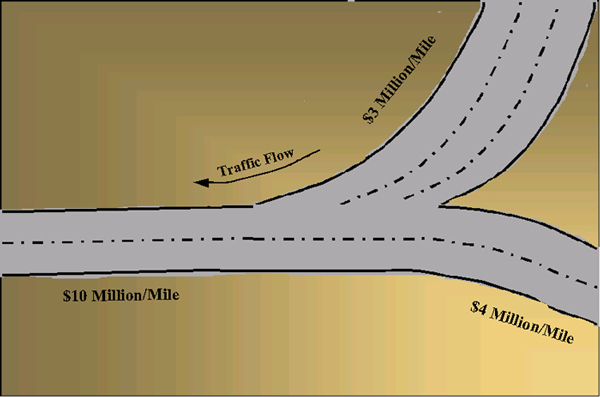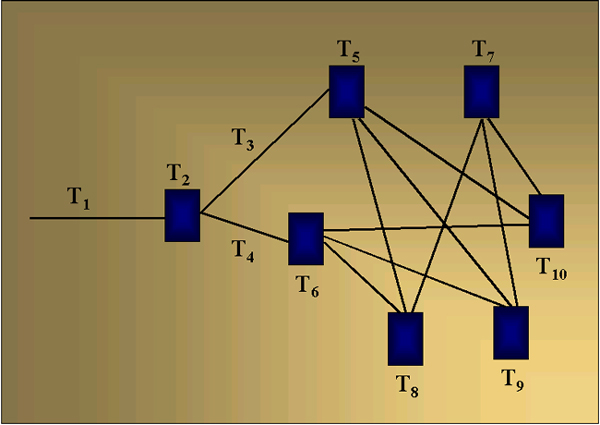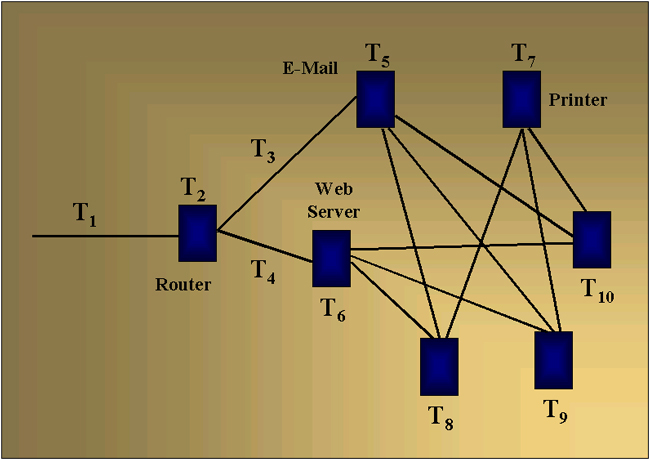
Bottlenecks
| Introduction. Bottlenecks are defined as a narrow passage or point of congestion. Anytime someone is analyzing and designing systems with flows it is important to identify the bottlenecks. For example, think of driving on highways when two highways merge into a single highway, particularly during rush hour. The following diagram should help to illustrate this. The dollar values on each highway section are "estimates" of the cost of adding another lane. |

Unfortunately, we have all been in such situations but
there are a few additional principles I want to mention.
Traffic intensity can be roughly estimated by a ratio of flow volume over flow capacity or T = V/C. The closer it gets to one, the worse the situation. |

If decisions to increase capacity of the roads were based purely on cost then they would add lanes on the upper trunk leading into the problem where it will only cost $3 million per mile. This would likely only make the problem worse. The value of adding lanes should override the cost and lanes need to be added on the left most section that currently only has two lanes, thus improving overall system capacity. Hopefully this starts to make it clear that there is little or no value to adding capacity to parts of a flow system that are not the bottleneck. In fact, doing this is likely to only make the bottleneck worse! Bottleneck Identification. When designing or modifying systems, identifying bottlenecks is one of the most crucial issues. Unfortunately, this is never an easy thing to do, particularly before a system has been implemented. Consider the following abstracted network diagram with trunks and devices and their associated traffic intensities. |

| At this point, you do not know anything about the
devices or lines. Some devices might be routers, printers, web
servers, e-mail servers, client computers or whatever. Some lines
might be T3, DSL, Fast Ethernet or whatever. But, you need to
remember that the overall capacity of the network is not determined by
its WAN connection to the internet, though this is likely to have a huge
impact. Some of these devices are not going to need as much
capacity depending on their role in the network. Other's
capacities will need to be examined thoroughly due to their crucial
nature in the overall operation of the network.
The next diagram gives a little more information, though it is still pretty abstract. |

| You should assume that devices 8, 9 and 10 represent
client machines. While this network could seriously use at least
one switch, we can still present the concepts I'm attempting to
elucidate.
The capacities on line 1 - line to the internet and device 2 - router are going to be very crucial to the overall performance of the network. But, maybe it is the case that almost all activity on this network is local and so purchasing a switch to improve internal bandwidth would be the best option. What I am trying to emphasize is that all decisions need to also be based on current demands and predicted demands. Fortunately, our traffic intensity measure, however limited, at least considers both demand and capacity. So, while working towards developing the mathematical equation that relates to identifying the bottleneck, remember the bottleneck has the traffic intensity or utilization that is closest to 1.0. The overall mathematical goal to get flows working smoothly is to minimize the largest traffic intensity. This is embodied in the following expression. |

| These sorts of strategies are called MiniMax objectives
since you are minimizing the maximum traffic intensity. While, we
are not going to get into these sorts of abstract formulations of the
problem very much in this course, it is important for you to understand
the concept of bottlenecks and bottleneck identification.
When designing networks everything in the network needs to be considered! |